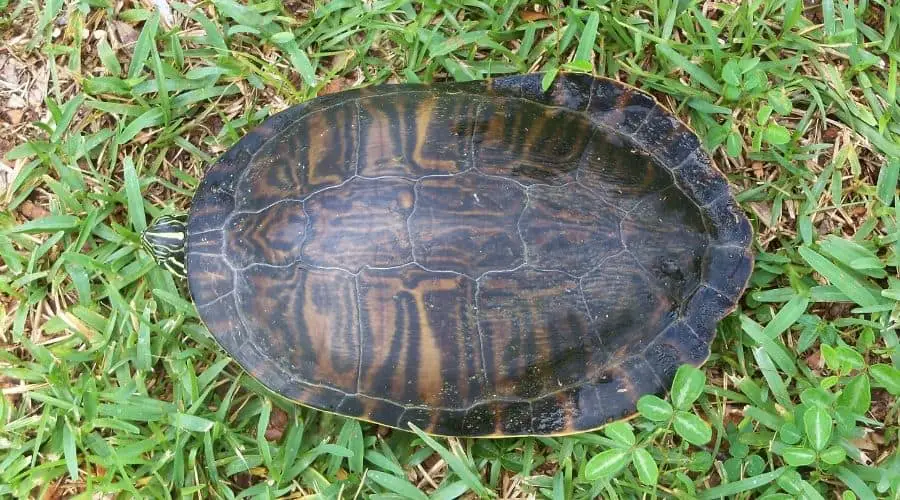Contrary to what cartoons would have you believe, turtles are attached to their shells. They can’t take them off because a turtle’s shell is part of its skeleton, also known as an exoskeleton or carapace.
Some people believe turtles shed their shells, but they actually have the same one their whole life. Do turtle shells grow?
A turtle’s shell never falls off and it grows with the turtle. Rather than being inside their shell, the 50 bones that make up the plates are a part of a turtle’s spine and ribcage. Outside the shell are scutes made of the same keratin as human hair and fingernails but formed into flat, bony plates that protect them from predators.
Table of Contents
Do Turtles Shells Grow With Them
Turtle’s shells do grow with them. Just as you are born with a spine and ribs, which grow larger as you age, so does a turtle’s shell.
The bones and scutes, or a thick hyde in the case of soft-shelled turtles, expand along with the individual turtle, so its shell is never too large or too small.
Some shell-wearing species like hermit crabs only borrow the shells of other species, sizing up as they grow and leaving behind the old shell, not turtles.
If you find a turtle shell without a turtle inside, sadly, it has died. The soft inner parts of the body either decomposed or were eaten.
An average turtle lives longer than most house pets. The shortest-lived are Map turtles which might only live about fifteen to twenty years.
Meanwhile, the biggest and longest-lived turtles like the Galapagos tortoise can live more than a century. All that time, their bodies and shells grow.
Since a turtle’s shell is part of the bones in their back, it grows as they age. In the first part of their lives, like other creatures, the shell will grow more rapidly and then slow down as they reach maturity.
According to Pet MD, “Turtles generally reach maturity between 5 to 8 years of age, and for tortoises, it can be as many as 20 years to reach full maturity.”
You can get a general idea of your turtle’s age and relative maturity by comparing it to another of the same species and gender.
Female turtles, and their shells, tend to grow larger than males, and smaller turtles are typically younger. However, external influences can affect a turtle’s growth rate.
How Do Turtle Shells Grow
Turtle shells grow like any other bone structure. Over time the turtle’s growing body adds calls, and the carapace bones become larger, much like a human’s leg bone or skull.
However, unlike our bones, the turtle’s carapace is outside, fully enclosing all of its vital organs.
Turtle shells are made of three main parts. The top, or carapace, is the domed part, and the underside is called a plastron. Between the carapace and the plastron is the bridge which connects the other two segments of the shell.
The evolution of turtle shells as a protective outer layer isn’t entirely bone. Turtles also have keratin or scutes, which are the part you can see on top.
These unique plates are only the outside layer of a more complex structure. Like the rest of the shell, they get more prominent as the turtle grows.
Soft-shelled turtles lack scutes. Instead, they have a thick layer of protective skin outside of their bony shell, which is where they get their name.
How Do Box Turtle Shells Grow
The Box turtle or Terrapene Carolina is an incredibly popular pet. Sadly, not enough people realize what they are getting into when raising these tiny turtles.
While they only tend to grow five to seven inches long with small shells, they can live fifty to a hundred years.
Hatchling box turtles are tiny, with a shell only about an inch long. This species doesn’t reach the majority of its size for ten years.
By that time, they’ll be just shy of five inches on average. After age ten, they can grow a few more centimeters, but their growth rate is significantly reduced.
According to All Turtles, “The older (Box turtles) get, the slower their growth rate. During the early stages (between ages 0 and 5), expect the common box turtle to grow at a rate of about 10 mm (1 cm) a year. Between ages 5 and 10, expect the turtle to grow at a rate of just 8 mm (0.8 cm) per year.”
Do Turtle Shells Grow Back
Turtles cannot grow their shells back. In addition to the myth that turtles shed their shells, many assume they can regrow a completely broken shell. Fortunately, they can heal most cracks.
The downside to being a slow-growing creature with thick bone and keratin plates on your back isn’t the speed you walk, but rather the speed you heal.
It will take between 4 and 18 months for a cracked shell to become stable again, but the turtle isn’t recovered.
It will likely take more than two years to heal if the crack doesn’t kill the turtle. A fracture is slow enough to repair for average human or animal bones, but shell damage can take a stunning 30 months for turtles.
That said, a turtle who gets well again after taking significant shell damage is unquestionably one of the fortunate ones.
Helpful Tips To Know If Turtle Shells Grow
Turtle’s shells begin growing inside their shells before they ever hatch. Whether it lives twenty years or a hundred and twenty, your turtle will have the same shell its whole life.
Here are more facts to know if turtle shells grow.
- A turtle could not live without its shell. Their outer shell connects to the ribs, spine, and nerve endings. Even if you could remove a turtle from its shell, it would only survive for a few minutes at most.
- Turtles are not tortoises, but all tortoises are turtles. According to Brittanica, “…they belong to the order Testudines or Chelonia, reptiles having bodies encased in a bony shell…” Tortoises live exclusively on land, while the rest of the turtle family spends some of its time in the water. Regardless of lifestyle, both turtles in general and tortoises specifically have shells that grow with them.
- Not all species of turtle can hide their heads inside their shells.
- A turtle’s shell has a blood supply and nerve endings, so they feel it when something touches them. Many turtles enjoy having their shells rubbed just as dogs and cats enjoy being petted. Sadly, this also means that any damage to a turtle’s shell causes it pain.
Final Thoughts
Turtle’s shells aren’t like clothing they can take off on a whim. The shell forms along with a baby turtle in the egg and will grow its entire life.
Younger turtles and their shells grow much faster, but they will still get larger very slowly even after reaching maturity. Whether they’re soft-shelled or have scutes, all turtles need their shells to survive since they are made from bones connected to their spine and ribs.
Sadly, a cracked or broken shell can quickly kill a turtle. If they are lucky enough to heal, it can take years, but luckily, turtle shells are incredibly tough.

